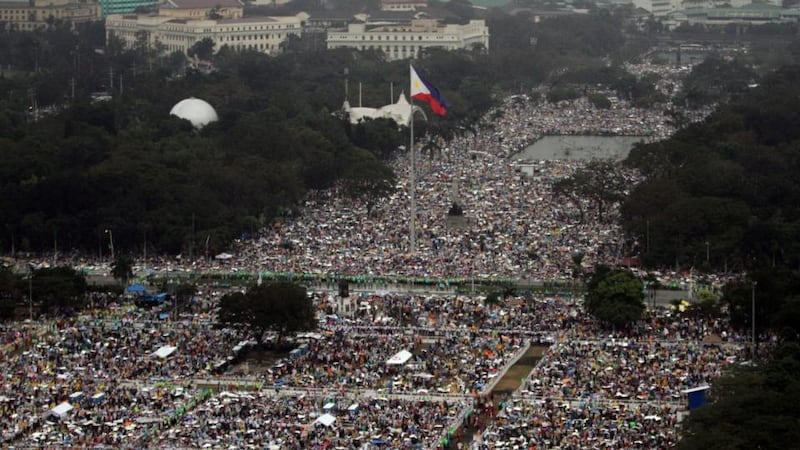Pope Francis concluded his trip to Asia on Sunday with an open-air Mass for a rain-drenched crowd in Manila that the Vatican and the government said drew up to seven million people, the largest ever for a papal event.
Vatican spokesman Father Federico Lombardi said the office of the president told the Vatican that between six and seven million attended the Mass in Manila‘s Rizal Park and surrounding areas.
“We are not able to count all these people, obviously, or to verify this, but in any case, we have seen so many people that we believe that it is possible,” Fr Lombardi told a briefing.

"If this is true, and we think it is, this is the largest event in the history of the popes," he said, noting that Pope John Paul drew some five million to the same area in 1995.
The 78-year-old pope, wearing a transparent yellow poncho over his white cassock, was driven through the ecstatic crowd in a "popemobile" modified from a jeepney, the most popular mode of transport in the Philippines which is based on a US military vehicle used in World War II.
He stopped often along the route to kiss children and bless religious statues on the day the Philippines celebrates the feast of the infant Jesus. The faithful, also wearing ponchos, held up rosaries in a forest of uplifted arms as he passed by.
Some people in the capital of Asia‘s only predominantly Catholic country had waited all night for gates to open at dawn. The gates opened nine hours before the start of the Mass, which was due to last nearly three hours.
In his homily, the pope urged Filipinos to shun “social structures which perpetuate poverty, ignorance and corruption,“ a theme he stressed when he held talks with president Benigno Aquino on Friday. Aquino attended the Mass.
Pope Francis also took another swipe at the government‘s population control efforts, saying the family was under threat from “insidious attacks and programmes contrary to all that we hold true and sacred.“
Street Children
The pope’s last full day in the Philippines began with an emotional youth gathering at a Catholic university in Manila, where he was moved by a question posed by a 12-year-old girl who had been abandoned.
“Many children are abandoned by their parents. Many of them became victims and bad things have happened to them, like drug addiction and prostitution. Why does God allow this to happen, even if the children are not at fault? Why is it that only a few people help us?” the girl, Glyzelle Iris Palomar, asked him.
The girl, who was rescued and found shelter in a Church-run community, broke down in tears and could not finish her prepared welcome. The pope hugged her and later put aside most of his own prepared speech to respond.
“Why do children suffer?” the Argentine Pope said, speaking in his native Spanish. An aide translated his words into English for the crowd of about 30,000 young people on the grounds of the Church-run university.
“I invite each one of you to ask yourselves, ‘Have I learned how to weep ... when I see a hungry child, a child on the street who uses drugs, a homeless child, an abandoned child, an abused child, a child that society uses as a slave‘?” he said.
Children can be seen living on the streets of the Philippine capital, as they often do in many poor Asian countries, surviving by begging and picking through garbage in vast dumps.
The United Nations says 1.2 million children live on the streets in the Philippines. According to the Child Protection Network Foundation, 35.1 percent of children were living in poverty in 2009, the last year such data was available. Nearly 33 percent of Filipinos live in slums.
Reuters








